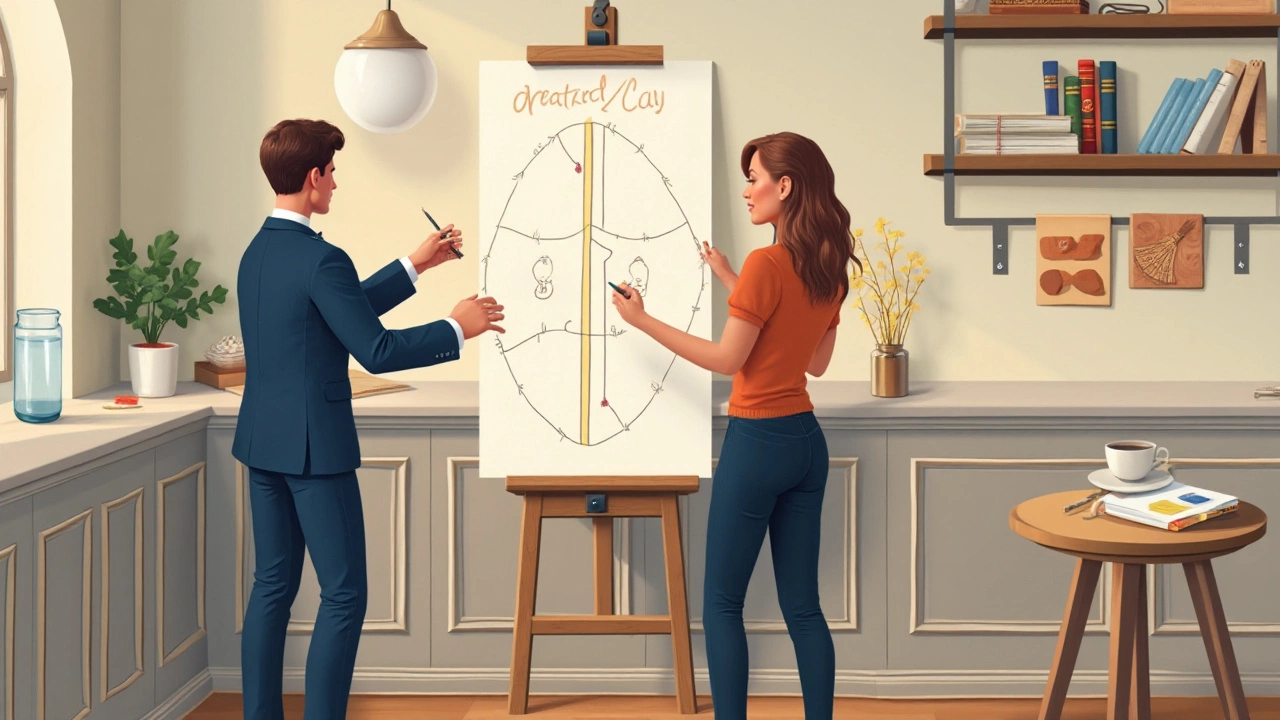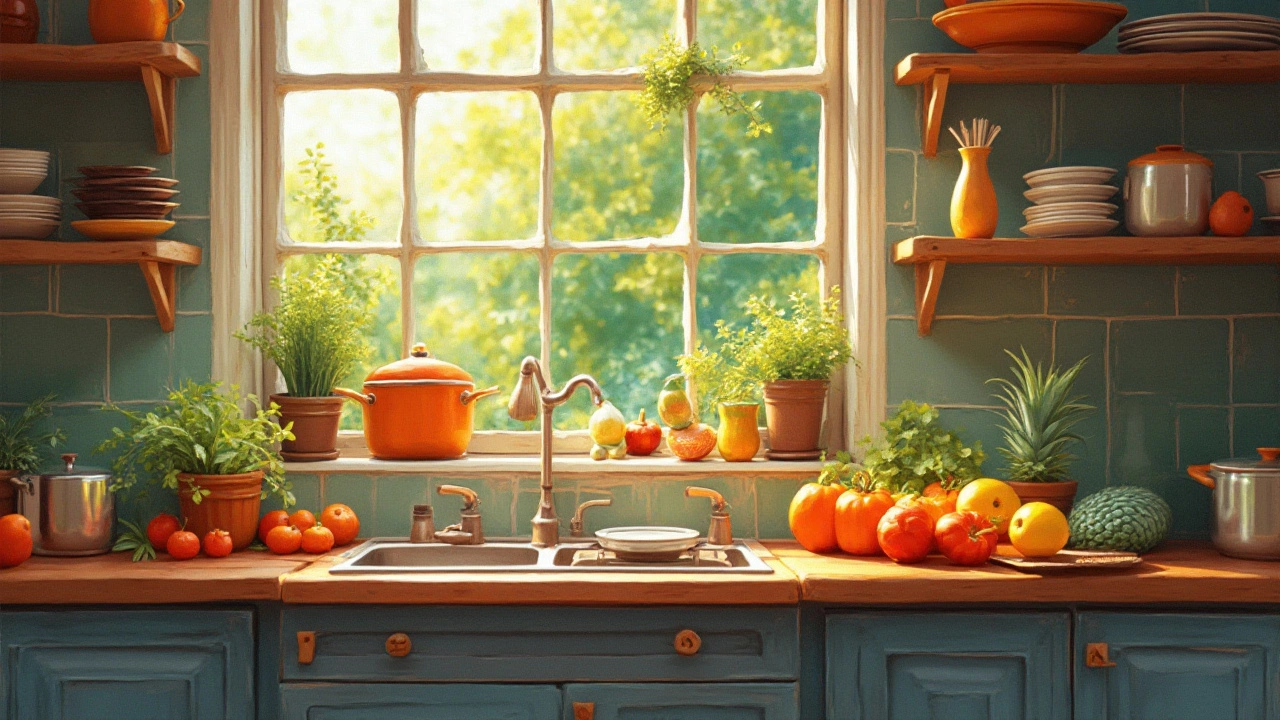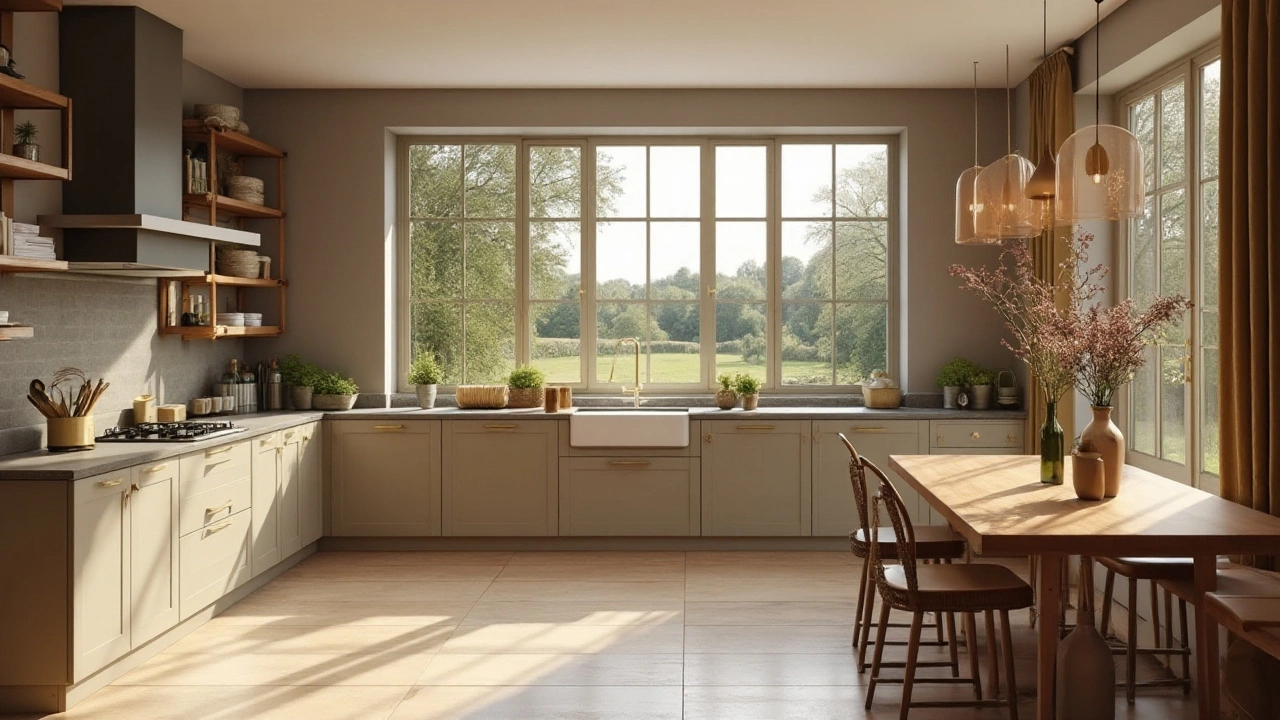Have you ever walked into a room and felt inexplicably at ease, as if everything was just perfectly in place? There's a good chance the magic behind those harmonious surroundings is something called the golden ratio. This age-old design principle, rooted in mathematics, has been shaping spaces and structures for centuries.
In the world of kitchen design, the golden ratio offers more than just beauty—it's about optimizing space and enhancing functionality. By embracing these symmetrical principles, homeowners can create a kitchen that is not only visually appealing but also highly effective. It’s a delicate dance between aesthetics and practicality, striving to balance the two.
Whether you're planning a complete kitchen makeover or just looking to tweak a few elements, understanding and applying the golden ratio can transform your cooking space in remarkable ways. Let’s explore how this timeless concept can breathe new life into your kitchen.
- Understanding the Golden Ratio
- Historical Significance in Design
- Practical Application in Kitchens
- Maximizing Space with Symmetry
- Innovative Design Ideas
Understanding the Golden Ratio
When you hear the term 'golden ratio,' you might picture ancient Greek sculptures or renowned Renaissance artworks. But this isn't just an art-history anecdote; it's a mathematical principle that defines beauty in proportions, echoing through time and nature. The golden ratio, often symbolized by the Greek letter phi (Φ), is approximately 1.618. This seemingly simple number occurs when a line is divided into two parts in such a way that the longer part divided by the smaller part is equal to the whole length divided by the longer part. Its application is prevalent in art, architecture, and even the spiral patterns of shells and galaxies, spreading its influence far and wide.
Historically, the golden ratio was deemed the most aesthetically pleasing proportion, making appearances from the Pyramids of Giza to the Parthenon in Athens. Architects and artists alike have been captivated by its balance, leading them to draft their works around this mystical number. During the Renaissance, artists like Leonardo da Vinci used it to inform the composition of masterworks, embedding phi subtly within their paintings and sculptures.
"Mathematics, rightly viewed, possesses not only truth but supreme beauty," as Bertrand Russell once articulated, capturing the allure of such numerical perfection in our lives and surroundings.Geometry tells its own story, and the golden ratio stands as a testament to the hidden beauty of numbers.
Our journey into the world of kitchen design brings the golden ratio right into the heart of the home. Imagine a kitchen layout where the stove, sink, and refrigerator form a perfect triangle, not just by convenience but by harmonious proportion. A living space reflective of such balanced ratios not only enhances functionality but also offers a feast for the eyes every time you step in. It stands as a reminder of how these age-old principles shape modern comforts. Consider this: researchers once found that people are naturally drawn to faces they perceive to have proportions close to the golden ratio. Now, apply this magnetism to your culinary environment, and you craft a space that inherently draws people in, keeping them engaged and serene.
What's fascinating about the golden ratio is its universality, transcending beyond designs or art alone. It’s something we live with daily, numbers in our DNA sequences align closely with phi, and even financial markets supposedly move in its rhythms. Translating such harmony into the design of our homes, especially in more intimate spaces like kitchens, represents an opportunity for real-life magic. Achieving this harmony through deliberate design not only enriches your living environment but instills a profound sense of satisfaction and well-being, seen and felt through visual appeal and practical convenience alike. Let’s reflect on how this classic idea can revolutionize not just art or mathematics, but the very place where we feed both body and soul.
Historical Significance in Design
Throughout history, the concept of the golden ratio, also known as the divine proportion, has captivated the minds of architects, artists, and designers alike. This mystical number, approximately 1.618, has often been heralded as the epitome of beauty and balance. The Greeks were among the first to explore this captivating proportion, incorporating it into their art and architecture. The Parthenon in Athens, for instance, is a testament to their understanding, with its facade dimensions believed to align closely with the golden ratio. This principle offered a framework that guided the layout and aesthetics, aiming to evoke a sense of natural harmony.
The Renaissance brought a resurgence of interest in this enigmatic ratio, as artists like Leonardo da Vinci and architects like Palladio sought mathematical perfection in their creations. The "Vitruvian Man," sketched by Leonardo, demonstrates a fascination with human body proportions fitting into geometric shapes, symbolizing a blend of art and science. During this period, the golden ratio influenced not only canvas and structures but also interior spaces, emphasizing a sense of proportion that transcended conventional design boundaries.
As time progressed, the influence of the golden ratio extended beyond grandeur architectural feats and into more personal spaces like our homes. Designers began to play with scale and symmetry, incorporating this golden principle into everyday objects and spaces. This shift was significant because it demonstrated that aesthetics and functionality could coexist harmoniously, serving both utilitarian and aesthetic purposes.
Art and architecture can be seen as a fusion of mathematical calculations and perceptual beauty," suggests renowned designer John Pawson.His observation highlights the unique allure of the golden ratio, a concept that continues to inform and inspire contemporary interior design, including kitchen design. The idea is not merely about fitting proportions but about creating an environment where users feel enveloped in an inexpressible sense of rightness.
Intriguingly, modern technology offers designers the tools to analyze and apply these ancient principles more precisely than ever before. With algorithms and software capable of calculating the exact placements and dimensions that align with the golden ratio, achieving this timeless beauty in kitchen design has become more accessible. Yet, despite technological advancements, the core idea remains the same: To create a space that feels inherently balanced and comforting.

Practical Application in Kitchens
When it comes to kitchen design, the golden ratio isn't just a theory confined to the pages of ancient manuscripts—it's a tangible tool to craft spaces that feel balanced and intuitive. But how exactly can this somewhat abstract mathematical principle be applied within the tactile realm of kitchen drawers, cupboards, and worktops? The answer lies in its capacity to guide the decisions we make during the design process, ensuring that both aesthetics and functionality are kept in check. To achieve the golden ratio, the simplest approach is to divide the space into segments where the relationship of a larger part to a smaller part is approximately 1.618 to 1. This way, the larger section is more than just a backdrop; it becomes an integral part of an eye-catching composition.
One of the practical ways to incorporate this ratio is through the arrangement of the kitchen's main components: the sink, stove, and refrigerator, often known as the kitchen triangle. Ideally, the distances between these elements respect the golden ratio to facilitate ease of movement and efficiency. For example, if your sink is 5 feet away from the stove, then ideally, the refrigerator should be roughly 8 feet from both the sink and the stove, adhering to the 1.618 proportion. This simple adjustment can revolutionize the user's experience, making meal preparation smoother and less tiring.
Material and color choices are also heavily influenced by the golden ratio. The variety of surfaces in your kitchen should balance warm and cool tones, light and dark elements, in a manner that reflects this harmonious principle. For instance, if your large downsized granite countertop covers 1.618 times the height of the backsplash, it feels naturally appealing. Expert designers like Le Corbusier have long advocated for maintaining these types of proportions in structure and color to strike the right visual harmony, stating that "The materials of architecture are... subject to a simple geometry."
"The idea is to generate a rhythm throughout the space, a common flow amidst differences," says renowned architect and interior designer Kelly Hoppen. "Be it through the juxtaposition of cabinets or the interplay of textures, the golden ratio inspires layouts that just feel right."Finally, when choosing where to place decorative elements, designers often employ the golden ratio to naturally draw the eye to focal points without overwhelming the viewer. Open shelving that spans 61.8% of a wall, interspersed with closed cabinetry, ensures items displayed are noticed without the kitchen seeming cluttered. By thoughtfully considering how each piece fits into the whole, while maintaining the golden ratio’s proportions, anyone can transform their kitchen into a space that’s pleasing both to look at and to inhabit.
Maximizing Space with Symmetry
When it comes to kitchen design, perhaps no concept holds more sway than symmetry. The golden ratio, often associated with this idea, guides both the seasoned architect and the weekend DIYer in creating spaces that flow naturally and look inviting. Why do balanced spaces feel larger and more comfortable? It's all about perception and organization. Imagine walking into a kitchen where the sink, stove, and storage areas don't just meet your needs but align in a thoughtful arrangement. This method not only appeals to the eye but also gives the space a sense of order and efficiency.
Psychologist and author of "The Architecture of Happiness," Alain de Botton, suggests that spaces designed with proportions like the golden ratio promote psychological well-being.
"Symmetry in a room or a building can make us feel settled where asymmetrical places leave us distracted or disoriented," he notes.By harnessing this balance, we arrange our home spaces in a way that calms and soothes, turning routine chores into pleasant rituals. Start by assessing your kitchen layout—from countertops to cabinets. Instead of letting the microwave dominate a corner, consider centering it above the stove or alongside similarly sized appliances. Such placements allow for visual balance and more working room.
The practicality of symmetry isn’t confined to aesthetics alone; it’s highly functional. Picture how easy it is to navigate a kitchen when items are placed in a mirrored fashion. If your left hand finds the spices, the pots rest easily to the right. This logical organization reduces steps and increases productivity. The clearer the layout, the swifter the salad gets tossed or the pasta boiled. In some homes, using symmetry equates to doubling the usable area simply by decluttering and arranging everything in complementary halves. One effective approach might be utilizing open shelves in parallel rows, making every spice jar and cup of coffee an easy grab. By investing in this spatial trick, you save forever searching through deep cupboards.
For those looking to extend the magic of symmetry in cabinetry, consider a dynamic play of textures and colors tied together by a common theme. While the traditional approach leans towards identical cabinet doors across the top and bottom lines, a modern twist could involve varying designs with matching color tones. This approach keeps the eyes intrigued while remaining rooted in symmetrical balance. The practice finds a harmonious friend in lighting; pendants spaced evenly above the kitchen island or track lighting along evenly placed shelving can accentuate this balanced aesthetic. Lighting directs not only the eye but action too, providing focused work areas or ambient luminal synergy for peaceful dining experiences.
Incorporating symmetry driven by the golden ratio, far from being formulaic, invites innovation. It embraces everyday disturbances like odd corners by molding them seamlessly into the scheme. Picture elegant solutions like diagonally placing a countertop in a nook, converting a perceived inconvenience into an asset. With these tactics, every square inch in your culinary space becomes cherished real estate. The repeated proportions reflect more than mere geometry; they echo life lived beautifully. Less a framework and more an invitation, maximizing space with symmetry transforms kitchens from mundane to magnificent.

Innovative Design Ideas
When venturing into the realm of kitchen design, embracing innovation is key to crafting a space that not only serves its purpose but also delights the senses. The interplay of the golden ratio can inspire a variety of design ideas that breathe life into your culinary domain. Imagine soothing symmetry where your line of vision effortlessly dances from one element to another without interruption. This isn't just coincidence; it's the magic of the golden ratio in action.
Start by considering your cabinetry. Cabinets often occupy the largest visual space of the kitchen, thus setting the tone. Designing cabinet faces with panels that reflect the golden proportions can herald a subtle yet strong aesthetic appeal. Think of the cabinet colors complementing the natural light that streams into the kitchen and how that brings joy through its harmony. Bold pops of color or textured materials like reclaimed wood can become focal points, enriching the experience just like a fine painting in a gallery.
Lighting plays a pivotal role as well, offering both functionality and ambiance. Pendants that adhere to the proportions of the golden ratio not only illuminate your workspace but do so in a way that is balanced and serene. Properly scaled lighting fixtures can turn an ordinary kitchen into a stage where culinary magic happens. Use a set of three pendants over an island or dining area, keeping the spacing consistent with golden proportions. This aligns not only physical dimensions but also aesthetic delight, making every meal preparation an elegant affair.
Storage solutions with an eye on aesthetics and function offer another avenue for innovation. Shelving that follows the stark simplicity of the ratio might include artful displays of your cookbooks or a collection of pots and pans, with a placement that is pleasing to the eye. Maximize the visual flow by ensuring nothing feels cramped or cluttered, intentionally leaving some space subtly empty.
"Design is not just what it looks like and feels like. Design is how it works," observed Steve Jobs, a paragon whose thoughts on aesthetics resonate deeply with home interiors.
Finally, consider your kitchen's surfaces. Counters, backsplashes, and floors that embrace the essence of the golden ratio don't just function as background elements but are active participants in your kitchen's choreography. Ensure counter spaces are not only complementary in hue but also proportionate in size, creating a visual cadence that implies diligent thought and care. Choose materials that reflect light softly, such as quartz or marble, adding a touch of nature’s elegance. Visualize a central island as the heart of creation—equidistant from surrounding entities, commanding respect and admiration in its posture.
A simple change in thinking towards the golden ratio can transcend your kitchen from merely functional to an oasis where cooking and interaction become a joy. It's not about drastic overhauls but rather a gentle transformation through thoughtful adjustments. Let your kitchen echo the eternal dance of proportions, where each element, though distinct, sings as part of a harmonious whole.
